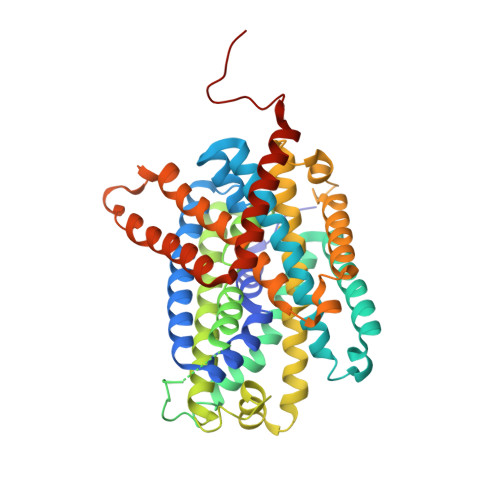Mechanism of substrate recognition and transport by an amino acid antiporter
Gao, X., Zhou, L., Jiao, X., Lu, F., Yan, C., Zeng, X., Wang, J., Shi, Y.(2010) Nature 463: 828-832
- PubMed: 20090677
- DOI: https://doi.org/10.1038/nature08741
- Primary Citation of Related Structures:
3L1L - PubMed Abstract:
In extremely acidic environments, enteric bacteria such as Escherichia coli rely on the amino acid antiporter AdiC to expel protons by exchanging intracellular agmatine (Agm(2+)) for extracellular arginine (Arg(+)). AdiC is a representative member of the amino acid-polyamine-organocation (APC) superfamily of membrane transporters. The structure of substrate-free AdiC revealed a homodimeric assembly, with each protomer containing 12 transmembrane segments and existing in an outward-open conformation. The overall folding of AdiC is similar to that of the Na(+)-coupled symporters. Despite these advances, it remains unclear how the substrate (arginine or agmatine) is recognized and transported by AdiC. Here we report the crystal structure of an E. coli AdiC variant bound to Arg at 3.0 A resolution. The positively charged Arg is enclosed in an acidic binding chamber, with the head groups of Arg hydrogen-bonded to main chain atoms of AdiC and the aliphatic portion of Arg stacked by hydrophobic side chains of highly conserved residues. Arg binding induces pronounced structural rearrangement in transmembrane helix 6 (TM6) and, to a lesser extent, TM2 and TM10, resulting in an occluded conformation. Structural analysis identified three potential gates, involving four aromatic residues and Glu 208, which may work in concert to differentially regulate the upload and release of Arg and Agm.
- Ministry of Education Protein Science Laboratory, Tsinghua University, Beijing 100084, China.
Organizational Affiliation:


















